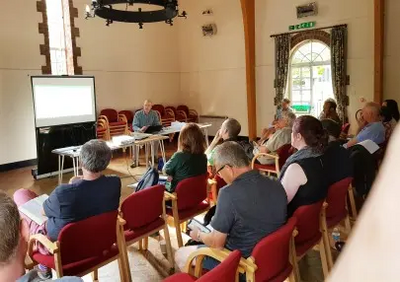Slow Progress in Developing Flood Control at Local Level - but Progress Nevertheless.

Six or seven years ago, the government passed much of the responsibility for flood mitigation onto Lead Local Flood Authorities (LLFAs) - in our case that is Hertfordshire County Council. Their role is to develop a strategy to monitor local flood risks within the county. They also draw up and maintain a record of structures, such as walls and embankments that might have a significant effeect on flood risk, recording their ownership and state of repair. This data is identified in the Hertfordshire Flood Risk Asset Register.
A non-technical summary can be found on tinyurl.com/y3snl3hq
However the resources they made available to the LLFAs for these new responsibilities were quite inadequate. Nevertheless over the last 5 years a huge amount of expertise has been built up in Hertfordshire and 2 at least of the county's worst flood risk spots have been (and are still being) closely investigated - one of these is Long Marston.
Last week Nick Hollinghurst, County Councillor for Tring & the Villages attended a flood management "event" at the Cecilia Hall in Puttenham entitled "Nurture and Nature", to which several organisations involved in flood mitigation contributed - most notably the Environment Agency.
The theme was basically "know your local situation in detail - and go with the flow!". Identify the most useful (and natural) lines of drainage and areas of land with higher permeability and build a strategy round that, directing water to areas where controlled flooding can be tolerated and finding dips and dells where stream water can be held back by natural features and "leaky dams" made of logs and branches from woodland thinning.
Two really encouraging points arose:
(1) the Environment Agency is simplifying its advice to landowners, setting thresholds below which permit applications for small works are not required and providing free assessments for local landowner proposals. HCC is working with them to provide website pages and printed literature to help inform local communities on the issues.
(2) informal local "Flood Protection Committees" working with the local parish councils and the county councils are springing up all over the country and we have an especially effective and knowledgeable one in Tring Rural Parish.

But also two warnings arose:
(1) we urgently need to reduce the top-soil erosion of farmland which currently routinely happens after heavy rainfall events - with or without actual "flooding". We were told that at present rates of soil loss UK farmers have only 90 harvests left.
(2) it is impossible to stop floods happening - we have to learn how to reduce flooding frequency, to mitigate the effects and to learn how to plan for and live with future flooding effects.
After the "event" Nick Hollinghurst observed, "I'm pleased that HCC has enough funding now to engage a specialist member of staff to supplement the existing team. This has in particular improved communication with local people in flood risk areas - in Puttenham the local Parish Council was well represented. Flood risks are far more complicated at local levels than you could ever imagine and height differences of inches can make huge differences. Fortunately there are radar based satellite systems that can penetrate surface vegetation and give land sufaces accurate to about a quarter of an inch, but the all-important matter of ground permeability need boreholes in detail. An inch or two of subsurface clay can be disastrous.
The presence or absence of old pipes in the ground or the location of buried services is however a universal problem - and will be for a long time until they are all located and accurately mapped. Already one idea has had to be junked due to the unexpected presence of a gas main.
Despite the usual lack of resources, however, I am impressed by the progress the HCC team and the local "flood groups" have made - from a standing start less than 5 years ago."
Cllr Hollinghurst concluded, "Summer showers can be very heavy and sudden and in many case can fall on hard surfaces or hard ground. Borough and District councils can help greatly by ensuring that the roads and gutters are kept swept and clean and free from mud, gravel and litter so that the gutters flow freely and the gulleys do not get filled up and bloked. Counties can also help by ensuring the gulleys undermeath the grids are regularly emptied and indeed HCC has helped by increasing the routine clean fro every 18 monts to annually and in known difficult situations down to every 6 months.
The government could also help by a change in regulation. 10 or more years ago a planning requirement was introduced requiring all new drives, roadways or made up surfaces to be permeable or able in other ways to allow water to soak away into the ground - the so-called SuDSs (Sustainable Drainage Sytems). This was quickly - you could say "watered down" - so that the specifications were non-statutory, regulations applied only to developments of over 10 dwellings and the Local Planning Authority did not need to attach SuDS requirements to planning permissions. This relaxation to the need for SuDS no longer serves to protect communities from flooding as originally intended - it now just serves to protect developers' profits. It needs to be tightened up again."
